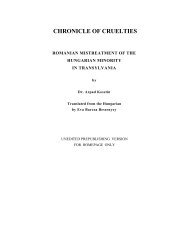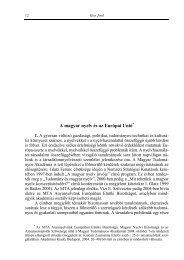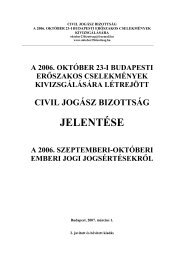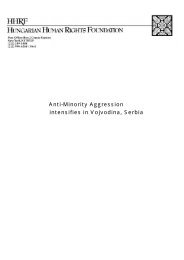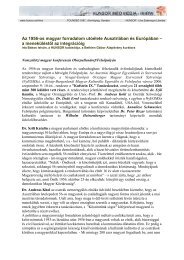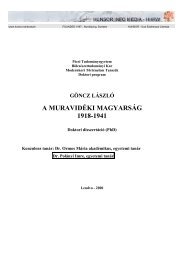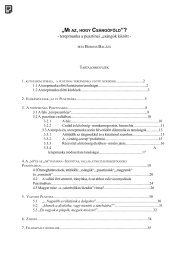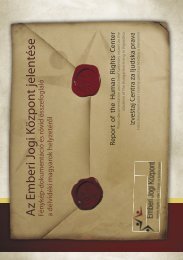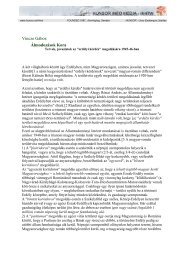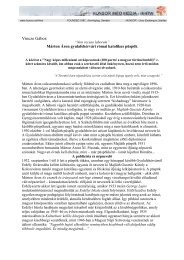"I understood that through the OZNA, he had exact information about the nature of thecleaning. If there had been but a few war criminals killed, he would not even have beeninformed. I can only estimate the proportions the massacre took, and that rather withoutresponsibility, I should say. On the whole territory of Szabadka including the Germans that wereexecuted here when the partisan brigade left, some three hundred and fifty people were executed.To me it is just as much reprehensible as what the Hungarians had done some time before."Let us add to the statement, which tries to mitigate and deny the responsibility of theofficer, the recollections of two young people who managed to survive."I passed my final exam in the grammar school of Szabadka in 1942. In my class therewere three or four Serbians, three or four Bunjevaces (a small Slavic ethnic group, related to theSerbs) and one or two Jews (Francois Bondy, for example, the literary expert living inSwitzerland) besides the Hungarians. Our relationship was characterized by true friendship andby the tolerance characteristic of the people living in Vojvodina. The people who taughtHungarian literature were Jozsef Bogner and Laszlo Erdelyi. They were people of great eruditionand eloquence, we were very fond of them. Both were executed by the partisans.Jozsef Bogner was for a while headmaster of the students' dorm. He became a teacherafter the town was reattached to Hungary and later became the Mayor of the town. His eldersister was a nun called Margit Bogner. Her suit for beatification is in progress now.After the fighting, there were three students from the grammar school who were leadersof the occupying partisan groups: Radak Milos, Jelics Dusan and Dezso Pinter (his father wasHungarian, his mother Serbian but he declared himself a Serb). As far as we know, the weekbefore the executions they had Jozsef Bognar repair all the clocks of the partisans,since he alsohad a127watchmaker's certificate. At early dawn, he was executed together with Laszlo Erdelyi. It is saidthat their judge and the executor of the verdict was Dezso Pinter.""Several days after they arrived, news began to spread that so and so was taken away andkilled. On a November night we were wakened by a loud pounding. Peeping through the slits inthe shutters, we heard that our neighbors were directing the armed men to the house at thecorner. That was when I saw men and women pressed together on a peasant horse cart. The cartstopped in front of our house. Holding our breath, we were wondering what was to happen sincemy father was leader of the Turan Hunters in Szabadka. He had been imprisoned once for twoyears for the Hungarian cause in Serbian times, for which he also got the Hungarian NationalDefence Cross after 1941. People were killed for lesser "crimes" than that . It was on this nightthat Devavari was taken from next door, then the shoemaker Elizak from the other end of thestreet. It was also this night that the Kiss brothers and Janos Csiszar disappeared; they nevercame back. It was one of those days that the wholesale merchant Geza Nojcsek, president of theHungarian Readers Circle, was killed.They also killed our teacher of Hungarian, Laszlo Erdelyi, who had just come home as aReserve Lance Sergeant. He was wounded in the arm during a shooting at the station. His oldSerbian students took him to the first aid station, then took him home; they assured him he was
safe. Unfortunately, as word spread around town, one student, who the teacher had failed, hired athirteen-year old lad to take him away. He was never seen alive again.What could Istvan Kuden have done? He was a Czech, who did not speak perfectHungarian and served art as a double-bass player in the theater orchestra of the HungarianReaders Circle. It might have been since living on Parhuzamos Street, in the ghetto area andbeing a hobby gardener, he refused someone a lettuce.During the first elections at the courthouse, one could look at the list of people who wereeliminated. I did not dare to look at the list, but my mother went ti see if my father and mybrother would be on it. Some one thousand names were listed, but the list was rather inaccurateand our people were not on it. The list was hung in three rooms each labelled "enemies of thepeople", "traitors" or "Fascists". Where this list is or whether it still exists at all, no one knows."In 1948, one could inquire about those who had disappeared. It128was Istvan Vukovics, later president of the Supreme Court of Vojvodina who, in 1944,announced that all those who had "disappeared" were dead. The authorities were willing tocertify the innocence of those who had been certifiably executed wrongly. During the first daysof the distribution of the certificates there was such an onslaught of relatives at the court that thepresident, fearing rebellion, stopped the distribution of rehabilitation papers. Those who did notget one then, would regret it later. Many, out of hatred for the murderers, did not ask for paperstestifying to the innocence of their relatives. Many of them paid for it, since they could notprove the innocence of those who had been executed, they were deprived of all their belongings.Among the executed people, there were many in transit; these people were seized at thestation. Those who could not certify themselves were promptly executed. It was chiefly theHungarian soldiers or deserters from the army that fell victim to their desire for freedom.APATIN - KULAIn Apatin would have been no reason for reprisals since no one was killed when theHungarians came in, yet some three hundred people were killed by the partisans. Some of themon the spot, but the majority were taken to Zombor to the notorious Kronich Palace, where afavorite means of torture was making captives run on hot coals; the name of the chief torturerwas not forgotten, Zika Laszics. Those who were burnt in this way knew that the next day theywould be shot either by the Danube or on the race course. Those who were not taken to Zomborwere taken to prison camps by the hundreds. There they died of hunger or of different diseases.Some survived, only to die from the greasy feast in their honor; when they returned to theirhome, their stomach just could not take it. That is how the number rose to three hundred.In 1941, a big celebration was held on the main square of Kula. The parish priest camewith his curate. When the chief spokesman began to abuse the Serbians, the priest left the squarein protest and hardly veiled disapproval; his curate joined him. The incident was not forgotten bythe Serbians present who on December 11 and 13, during the days of the Kula massacres; they
- Page 3 and 4:
Library of Congress Catalogue Card
- Page 5 and 6:
Mutilation of the hands or feet wit
- Page 7 and 8:
they wanted to belong. On the annex
- Page 9 and 10:
individuals, then shooting them by
- Page 11 and 12:
the Russians and under their protec
- Page 13 and 14:
22PEOPLE OF BEZDAN1.On a May aftern
- Page 16 and 17:
26that those people all fell victim
- Page 18 and 19:
ack a 13 year-old boy to the soccer
- Page 20 and 21:
Russian officers cursed and told th
- Page 22 and 23:
Jani was set free for he had been a
- Page 24 and 25:
There were some people who, in spit
- Page 26 and 27:
March 12, 1945. The relatives of th
- Page 28 and 29:
Ferenc Csapo, 33 Mihaly Miovacs, 18
- Page 30 and 31:
Having heard about the advance of t
- Page 32 and 33:
"On November 3, I got up at five in
- Page 34 and 35:
The vicar would come every night. H
- Page 36 and 37:
hand. Raising it to his mouth, he d
- Page 38 and 39:
"24th October, 1944. Yesterday was
- Page 40 and 41:
"I have only one chance to be sacri
- Page 42 and 43:
The data, which shows that on the s
- Page 44 and 45: all the captured Serbs, as neither
- Page 46 and 47: Before and during World War II, the
- Page 48 and 49: would order fire in an instant. Wit
- Page 50 and 51: Our house looked out over the main
- Page 52 and 53: He had just arrived home after thre
- Page 54 and 55: 28. Jozsef Pasztor, 34 56. Albert G
- Page 56 and 57: The OZNA officer, who exhumed a mas
- Page 58 and 59: 7917 year old Karoly and 8 year old
- Page 60 and 61: 82FROM SZENTFULOP TO THE GAKOVA CAM
- Page 62 and 63: My mother died on January 4, 1946.
- Page 64 and 65: Jozsi, the leader of our committee
- Page 66 and 67: his own grave, then machine gunned
- Page 68 and 69: driving a wheelbarrow on the sidewa
- Page 70 and 71: "Now that's exactly what we needed
- Page 72 and 73: 15 Istvan Polyakovics, Zenta, 18861
- Page 74 and 75: idge was built (from several rows o
- Page 76 and 77: There is a common opinion among the
- Page 78 and 79: The Catholics of the village were o
- Page 80 and 81: and their supporters. On one occasi
- Page 82 and 83: "My younger brother, Bandi, was tak
- Page 84 and 85: two young instructors staying in he
- Page 86 and 87: In Tunderes (Vilova) there was no o
- Page 88 and 89: weeks spent starving, laying on str
- Page 90 and 91: 121PACSERAt Pacser sixteen Serbians
- Page 92 and 93: piece of land, there are three rows
- Page 96 and 97: took the priest under their protect
- Page 98 and 99: "We set off from Hadikliget on Octo
- Page 100 and 101: everyone to the front! The Party us
- Page 102 and 103: 137REPORT OF LOSSESIn addition to o
- Page 104 and 105: 141Source: Zlocini okupatora u Vojv
- Page 106 and 107: well as in words, that there had be
- Page 108 and 109: The American military forces delive
- Page 110 and 111: culpability or participation are th
- Page 112 and 113: The accused did not make use of his
- Page 114 and 115: the spirit of revenge among the Hun
- Page 116 and 117: considered all the claims of Hungar
- Page 118 and 119: The People's Court of Budapest just
- Page 120 and 121: From then on all hell breaks loose.
- Page 122 and 123: Recommended readingeRudolf Kiszlion



